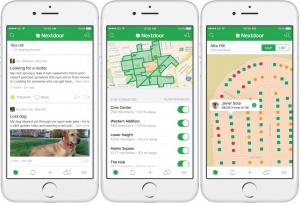Nextdoor
|
Nextdoor is a free social networking platform where users can engage and connect with their neighborhood and local community. They have over 210,000 active virtual neighborhoods, which includes nearly 90% of all neighborhoods in the United States. Nextdoor is currently available in the following countries: the United States, the United Kingdom, the Netherlands, Germany, France, Italy, Spain, Australia, Sweden, Denmark, and Canada [1]. These neighborhoods can be as small as 100 households to as large as 3000 households. Some uses of the application include: “finding a last-minute babysitter, planning a local event, or sharing safety tips.” Nextdoor is accessible through internet browsers such as Chrome, Firefox, Internet Explorer, and Safari[2]. Additionally, it has a mobile version for iOS and Android. The application has consistent features across all of these platforms, such as a news feed, neighborhood map, help map, crime and safety section, and more. Although Nextdoor defined a privacy policy available to all of its members, Nextdoor does raise ethical concerns, including harassment, racial profiling, and paranoia.
Contents
History
The company was founded by a group of seven friends in 2008 and has its headquarters in San Francisco, California. The original CEO, Nirav Tolia, resigned in 2018 and appointed Sarah Friar as the new CEO. According to the Harvard Business School Digital Initiative, Nextdoor took a similar approach to Facebook, which was initially restricted by universities, by restricting the network to residents. However, compared to Facebook, users turn to Nextdoor for “its reputation for privacy and a smaller community feel.[3]” The company was valued 1 billion dollars around five years after its creation.
Nextdoor Features
On the iPhone, Android, iPad, and online application, there are common features that users can navigate to.
News Feed
The front page consists of a News Feed, which can be sorted by "Top posts" or "Recent activity." The "Top posts" ordering is determined by neighbor distance, recency, activity, relevance, unread by you, and unresponded to posts[4]. Users have the option to post a message, event, poll, or urgent alert. Below that, there are posts from fellow neighbors from all categories.
Neighborhood Map
On another tab, there is a neighborhood map where one can interactively check out the other homes in your neighborhood that also have the Nextdoor application. There are also colors and boundaries on this map to see how involved the neighbor is on the platform. For instance, “green means that a neighbor has signed up at that address” and red means the opposite. Orange means that a neighbor has not signed up, but has been invited by another neighbor. Clicking parts of the map also gives more information on one’s neighbor.
Help Map
During the coronavirus outbreak, Nextdoor added this new interactive map to allow users to mark themselves as "free" to help neighbors with tasks "from grocery shopping to child care"[5]. As soon as one adds themselves to the map, the community will receive one's name, home location, a profile pictures, and a list of ways one can support one's neighbors. On the other hand, members will see those on the Help Map and be able to message them if they would like their support[6].
Crime & Safety
The Crime & Safety section is where users can report suspicious activity or safety issues to the neighborhood by posting a message or sending out an urgent alert. If an urgent alert is sent out, "Nextdoor will immediately send an email and a mobile phone text message to your neighbors.[7]"
Other features include: Groups, Business, For Sale & Free, Local Deals, Events, Real Estate, Lost & Found, Documents, and General.
Privacy Policy
Every “neighbor” on the service has to verify their address and members must use their real names to ensure online privacy. There are two ways to verify addresses: phone number and postcard. Nextdoor checks whether one’s mobile phone plan’s billing address matches their address or mails a postcard with a verification code to one’s address[8]. Each neighborhood is also protected with a user’s password and encrypted using HTTPS. Although Nextdoor relies on local and national advertisers to make money, conversations and its directory of names, addresses, and email addresses are not shared with these advertisers. The full privacy policy is transparent and can be found on their website for all customers.
Ethical Implications
Harassment
There have been accounts of cyberbullying on Nextdoor because it is not as well-monitored as other social networking platforms. Nextdoor is also a bigger safety concern because one is required to put their real name and home address[9]. Because neighbors are within close proximity of each other, online threats can lead to unsafe in-person interactions quicker. Public shaming has become quite the trend such as posts that target neighbors for not “watering their lawn enough.[10]” Nextdoor's goal is to create neighborly bonds; however, some say that the service also has the power to destroy them.
Racial Profiling
Nextdoor has a dedicated section called “Crime and Safety.” Many people were concerned that it enabled racial profiling[11]. According to Steven Renderos, senior campaigns director at the Center for Media Justice, "These apps are not the definitive guides to crime in a neighborhood — it is merely a reflection of people’s own bias, which criminalizes people of color, the unhoused, and other marginalized communities[12]." Nextdoor is not creating this bias, but is exacerbating it. This could be a case of emergent bias, as described by Philip Brey[13], which arises when the system is used in a way not intended by its designers. However, “Nextdoor has tried to eliminate racial bias on the site the same way it built its product: through smart product design...Tolia says the site has cut racial profiling in its crime and safety category by 75 percent.[14]” In particular, a user has to put two physical descriptors if they would like to include the race of the person when posting about a crime or suspicious activity, in the Crime & Safety section. Nextdoor uses an algorithm to check the user's post for racially charged terms and a lengthy and meaningful description[15].
Paranoia
The “Crime and Safety” section also has caused many people to feel more unsafe than they should in their own neighborhoods. According to an article in the Chicago Tribune, “people are committing crimes I've never even thought of: casing, lurking, knocking on doors at 11:45 p.m., coating mailbox flaps with glue, "asking people for jumper cables but not actually having a car," lightbulb-stealing, taking photos of homes, being an "unstable female" and "stashing a car in my private garage.[16]"” Some members value Nextdoor for keeping their neighbor safe, while others state that Nextdoor provides a platform for local communities to be more paranoid than safe.
Censorship
In 2020, Nextdoor was accused of censoring posts about Black Lives Matter and racial injustice. It came at a time where protests were arising across the United States with the killing of George Floyd. The CEO of Nextdoor, Sarah Friar, mentioned in an interview with the National Public Radio that it was their fault and that they should have moved more quickly to protect those posts. According to an article published by WXXI news there were many accusations towards Nextdoor of not doing anything about racists comments and complaints raised by some of the users on the platform. The CEO of the company, Sarah Friar mentioned that Nextdoor is taking more steps to improve their methods of moderation on the site. She also promised to start a campaign to recruit more Black moderators.
References
- ↑ Nextdoor. "Where is Nextdoor available?" Retrieved on 29 February 2020.
- ↑ Nextdoor. "Supported Browsers" Retrieved on 25 March 2020.
- ↑ HBS Digital Initiative. "Is Nextdoor the next big social network?" Retrieved on 26 March 2020.
- ↑ Nextdoor. "How to Sort Your Newsfeed" Retrieved on 25 March 2020.
- ↑ The Verge. "Nextdoor adds features to help neighbors during the coronavirus crisis" Retrieved on 25 March 2020.
- ↑ TechCrunch. "Nextdoor adds Help Map." Retrieved on 25 March 2020.
- ↑ https://help.nextdoor.com/s/article/About-Nextdoor-for-crime-prevention?language=en_US
- ↑ Nextdoor. "Nextdoor Privacy Policy" Retrieved on 29 February 2020.
- ↑ Komando.com "Simple way to protect your privacy on social media sites" Retrieved on 29 February 2020.
- ↑ The Mercury News. "Nextdoor: When a neighborhood website turns unneighborly" Retrieved on 29 February 2020.
- ↑ Buzzfeed News. "Racial Profiling Is Still A Problem On Nextdoor" Retrieved on 29 February 2020.
- ↑ https://www.vox.com/recode/2019/5/7/18528014/fear-social-media-nextdoor-citizen-amazon-ring-neighbors
- ↑ https://www.cambridge.org/core/books/cambridge-handbook-of-information-and-computer-ethics/values-in-technology-and-disclosive-computer-ethics/4732B8AD60561EC8C171984E2F590C49
- ↑ Wired. "For Nextdoor, Eliminating Racism Is No Quick Fix" Retrieved on 29 February 2020.
- ↑ NPR. [1] Retrieved on 25 March 2020.
- ↑ Chicago Tribune. "Nextdoor: Where paranoia lives" Retrieved on 29 February 2020.

